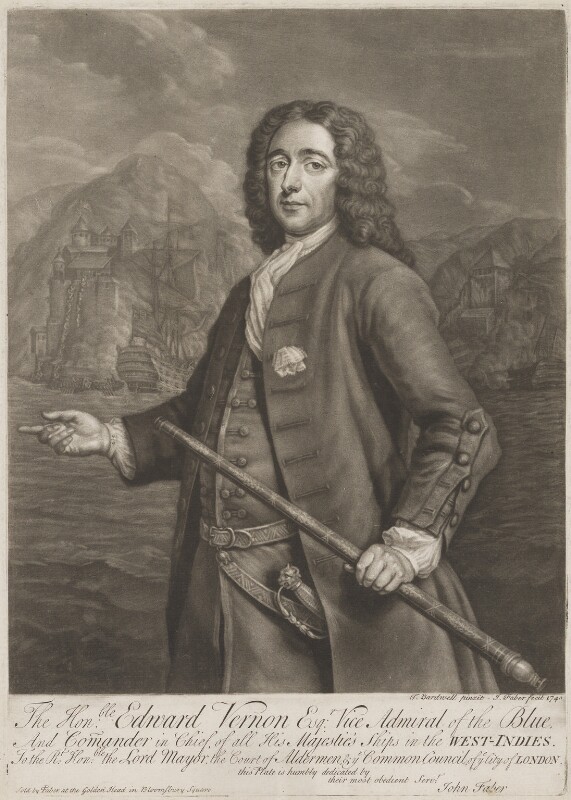The GROG SHM is presumably named for Edward Vernon. He served on Admiral Sir Cloudsesley Shovell’s flagship at the capture of Gibraltar. He was later captain of the ship that avoided disaster in the catastrophic loss of Cloudesley Shovell’s fleet on the Isles of Scilly in 1707.

After rising to the rank of Vice Admiral, he became an MP and was a critic of the Admiralty: this resulted in the loss of his rank (and pension?). He lived modestly in a cottage on the Broke Hall estate.
The Rum Ration
He is known for his 1740 order that rum should be diluted with water. He achieved many other things of much greater significance, seizing Portobello for instance.
Grog
The new drink was supposedly called ‘grog’ after his nickname ‘Old Grog’, related to his wearing of a grogram (a corded fabric) coat.
The Origins of Grog
[Order] By Edward Vernon, Esq., Vice-Admiral of the Blue, and Commander-in-Chief of His Majesty’s Ships and Vessels in the West Indies1Order and verses taken from Carr Laughton, L. G. ‘Grog’. The Mariner’s Mirror 5, no. 3 (1 January 1919): 89–90
” Whereas it manifestly appears by the return made to my general order of the 4th of August, to be the unanimous opinion of both Captains and Surgeons that the pernicious custom of the seamen drinking their allowance of rum in drams,2A dram is about a small teaspoonful (1/16 Ounce)., and often at once, is attended with many fatal effects to their morals as well as their health, which are visibly impaired thereby, and many of their lives shortened by it, besides the ill consequences arising from stupefying their rational qualities which makes them heedlessly slaves to every brutish passion, and which having their unanimous opinion cannot be better remedied than by the ordering their half pint of rum to be daily mixed with a quart of water, which they that are good husbands may from the savings of their salt provisions and purchase sugar and limes to make more palatable to them. You are, therefore, hereby required and directed, as you tender both the Spiritual and Temporal Welfare of His Majesty’s subjects and preserving sobriety and good discipline in His Majesty’s service, to take particular care that Rum be no longer served in species to any of the Ship’s company under your command, but that their respective daily allowance of half a pint a man for all your Officers and Ship’s company be every day mixed with the proportion of a quart of water to every half-pint of rum to be mixed in one scuttled butt kept for that purpose, and to be done upon deck, and in the presence of the Lieutenant of the watch, who is to take particular care to see that the men are not defrauded in having their full allowance of Rum, and when so mixed it is to be served to them at two servings in the day, the one between the hours of 10 and 12 in the morning, and the other between four and six in the afternoon. And you are to take care to have other scuttled butts to air and sweeten their water for their drinking at other times, and to give strict charge to your lieutenants in their respective watches to be very careful to prevent any Rum or other spirituous liquors being privately conveyed on board the ship by your own boats, or any others, as both you and they must expect to answer for the ill consequences that may result from any negligence in the due execution of these orders. For which this shall be your warrant. Given under my hand onboard H.M. ship the Burford, 21st August, 1740.
This resulted in…
A mighty bowl on deck he drew
Dr. Thomas Trotter – Ship’s Surgeon
And filled it to. the brink;
Such drank the Burford’s gallant crew, . And such the Gods shall drink;
The sacred robe which Vernon wore Was drenched within the same.
And hence its virtues guard our shore,
And Grog derives its name.”
Sources
Footnotes
- 1Order and verses taken from Carr Laughton, L. G. ‘Grog’. The Mariner’s Mirror 5, no. 3 (1 January 1919): 89–90
- 2A dram is about a small teaspoonful (1/16 Ounce).
- 1Order and verses taken from Carr Laughton, L. G. ‘Grog’. The Mariner’s Mirror 5, no. 3 (1 January 1919): 89–90
- 2A dram is about a small teaspoonful (1/16 Ounce).
Image Credits and Sources
- Edward Vernon: © National Portrait Gallery, London
